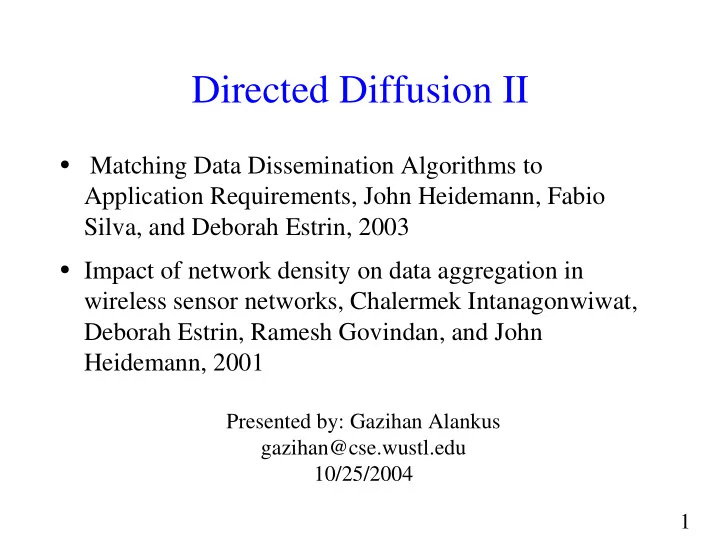

Directed Diffusion II ● Matching Data Dissemination Algorithms to Application Requirements, John Heidemann, Fabio Silva, and Deborah Estrin, 2003 ● Impact of network density on data aggregation in wireless sensor networks, Chalermek Intanagonwiwat, Deborah Estrin, Ramesh Govindan, and John Heidemann, 2001 Presented by: Gazihan Alankus gazihan@cse.wustl.edu 10/25/2004 1
Introduction ● Sensor networks require data dissemination protocols that are designed for the application needs ● No single protocol is optimal for all applications ● Appropriate protocol must be chosen based on the nature of the application 2
Introduction ● Choice of protocol greatly affects application performance Protocols Problems 3
Outline ● Directed diffusion and standard algorithms ● Proposed new algorithms – Push diffusion – Two-phase pull diffusion – Greedy aggregation ● Experimental results ● Conclusion 4
Directed Diffusion ● Sources and sinks – Sinks subscribe to sources – Data flows from sources to sinks – Data-centric ● Separate API and implementation – New implementations for same application 5
Directed Diffusion ● Standard algorithms – Two-phase pull – GEAR – Opportunistic data aggregation 6
Directed Diffusion ● Two-phase pull Network Sink Source 7
Directed Diffusion ● Two-phase pull Network Sink Source interest 8
Directed Diffusion ● Two-phase pull Network Sink Source interest 9
Directed Diffusion ● Two-phase pull exploratory data Network Sink Source 10
Directed Diffusion ● Two-phase pull exploratory data Network Sink Source 11
Directed Diffusion ● Two-phase pull reinforcement Network Sink Source 12
Directed Diffusion ● Two-phase pull data Network Sink Source 13
Directed Diffusion ● GEAR – Use geographic information instead of flooding – Flood in the destination region after reaching the destination 14
Directed Diffusion ● Opportunistic data aggregation – Aggregate data if similar data happen to meet at a branching node 15
Proposed Algorithms ● Idea: Among sources and sinks, silence the group that is more crowded in order to reduce traffic – Push – One-phase pull ● Idea: The chances of similar data meeting on network is low, make it higher – Greedy aggregation 16
Proposed Algorithms ● Push – Active sources – Passive sinks – Less floods than two-phase pull 17
Proposed Algorithms ● Push Network Sink Source 18
Proposed Algorithms ● Push Network Sink Source exploratory data 19
Proposed Algorithms ● Push Network Sink Source exploratory data 20
Proposed Algorithms ● Push reinforcement Network Sink Source 21
Proposed Algorithms ● Push data Network Sink Source 22
Proposed Algorithms ● Push – Advantages ● Less flooding ● Good for many sinks – Disadvantages ● Sinks cannot make requests ● Not ideal for few sinks 23
Proposed Algorithms ● One-phase pull – No exploratory data messages – Path is formed based on interest messages 24
Proposed Algorithms ● One-phase pull Network Sink Source 25
Proposed Algorithms ● One-phase pull Network Sink Source interest 26
Proposed Algorithms ● One-phase pull Network Sink Source interest 27
Proposed Algorithms ● One-phase pull data Network Sink Source 28
Proposed Algorithms ● One-phase pull – Advantages ● Less flooding ● Instant path – Disadvantages ● Link asymmetry ● Path formed based on the quality of reverse path ● Flow-id necessary 29
Proposed Algorithms ● Greedy aggregation – Instead of expecting similar messages to meet, overlap the paths and increase the chance – Delay messages to increase the chance 30
Proposed Algorithms ● Greedy aggregation 31
Proposed Algorithms ● Greedy aggregation 32
Proposed Algorithms ● Greedy aggregation 33
Proposed Algorithms ● Greedy aggregation 34
Proposed Algorithms ● Greedy aggregation – Advantages ● More aggregation ● Less traffic ● Even though nodes delay messages, overall delay is less than opportunistic aggregation – Disadvantages ● Dependant on the tree, does not tolerate dead nodes ● Although spends less battery in overall, main branches of tree spend more battery power than others 35
Experimental Results ● Push vs one-phase pull – Push is bad for many sources, OPP is bad for many sinks 36
Experimental Results ● Push vs one-phase pull with 5 sinks – Cost of push increases with number of sources, but better than OPP 37
Experimental Results ● Push vs one-phase pull – relative overhead – Overhead drops with more sources, fixed overhead is shared 38
Experimental Results ● One-phase pull – OPP is not good with many sinks 39
Experimental Results ● Push – Overhead of (a) exploratory data and (b) reinforcements 40
Experimental Results ● Push with GEAR and OPP with gear – Flooding not required with geographic information 41
Experimental Results ● Opportunistic vs greedy aggregation 42
Summary ● Push – Does not require the flooded interest messages – Sources advertise their data – Interested sinks reinforce ● Pros – Without interest messages, there is less flooding ● Cons – Not best with few sinks 43
Summary ● One phase pull – Does not require the flooded exploratory data – Does not require reinforcements – Sources use interest messages to find route ● Pros – Less flooding ● Cons – The route found is not always the best 44
Summary ● Greedy aggregation – Routes from the same path and introduces delays in order to make more aggregation ● Pros – More aggregation, less overall delay ● Cons – Depends heavily on the existing tree 45
Conclusion ● Underlying dissemination algorithm can greatly affect the performance of applications that use diffusion 46
Critique ● Explanation of some graphs are insufficient ● More real-life experiments necessary ● Since topologies are random, experiment results should also include the topologies used. Ex: Using the exact same topology for different algorithms (not explicitly mentioned) ● Experiments with asymmetric links would be interesting for OPP and TPP ● Power-oriented analysis is also necessary 47
Recommend
More recommend